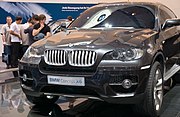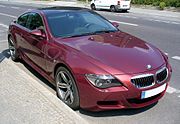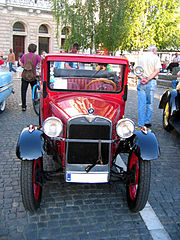The New Class (German: Neue Klasse) was a line of compact sedans and coupes starting with the 1962 1500 and continuing through the last 2002s in 1977. Powered by BMW's celebrated four-cylinder M10 engine, the New Class models featured a fully independent suspension, MacPherson struts in front, and front disc brakes. Initially a family of four-door sedans and two-door coupes, the New Class line was broadened to two-door sports sedans with the addition of the 02 Series 1600 and 2002 in 1966. Sharing little in common with the rest of the line beyond power train, the sporty siblings caught auto enthusiasts' attention and established BMW as an international brand. Precursors to the famed BMW 3 Series, the two-doors' success cemented the firm's future as an upper tier performance car maker. New Class four-doors with numbers ending in "0" were replaced by the larger BMW 5 Series in 1972. The upscale 2000C and 2000CS coupes were replaced by the six-cylinder BMW E9, introduced in 1969 with the 2800CS. The 1600 two-door was discontinued in 1975, the 2002 replaced by the 320i in 1975. The 1 Series was launched globally in Autumn 2004 and shares many structural, chassis, powertrain, hardware and electronic elements with the larger 3 Series. The model was started to provide a lower point of entry into the BMW range as the 3 Series moved gradually up-market. Initially launched as a 5-door hatchback, a 3-door version was also launched in July 2007. The 1 Series is priced between the MINI and the current E90 3 Series. Because the coupe is the only rear wheel drive vehicle in its class, it is somewhat considered the successor to the BMW 2002. The 1 Series coupe (E82) and convertible (E88) went on sale in the United States in model year 2008 as the 128i and the 135i. Other countries received the 120i and 125i in both platforms. The convertible, unlike the 3 Series convertible, uses a soft-top instead of a folding hardtop. This is lighter, cheaper to manufacture and preserves more trunk space than the folding hardtop would allow. The 1 Series is the only car in its class to offer rear wheel drive, perfect (50:50) weight distribution and highly advanced independent aluminum suspension. The BMW 3 Series is a compact executive car manufactured since model year 1975. The 3 Series is currently in its fifth generation, the E90 Current models include the sport sedan (E90), station wagon (E91), coupe (E92), and convertible (E93). Since its first generation, the 3-Series is considered to be the benchmark, and the 3-Series' competitors are often judged on how close they come to this car. In some countries, it has even outsold significantly cheaper models, most notably Ford Mondeo in the UK. The 3 series is one of BMW's most important models, as it accounts for a majority of its worldwide sales. A mid-size executive car. For model year 2008, BMW has revised the 5 Series with a slightly redesigned interior, subtle exterior details, and new motor options. The 6 Series is BMW's grand touring luxury sport coupe, based on the 5 Series' platform. Currently available as the 650i in coupe (E63) and convertible (E64) models in the United States, elsewhere available in a diesel and petrol straight-6 option - 630i & 635d. The BMW 6 Series returned in 2004 after a 15-year absence from BMW's model lineup. BMW's full-size flagship executive sedan. Typically, BMW introduces many of their innovations first in the 7 Series. For example, the somewhat controversial iDrive system debuted in the 7 Series. The 7 Series Hydrogen, featuring one of the world's first hydrogen fueled electric engines, is fueled by liquid hydrogen and emits only water vapor. Since the infrastructure for refueling a hydrogen fueled engine is not widely available, the V12 engine also runs on gasoline. Numerous engines power the 7 Series worldwide. BMW offers diesel, straight 6, V8 and V12 motors, as well as the Alpina tuned supercharged V8. It is also available in a bulletproof version.{{Fact|date=July 2007)} BMW's second crossover SUV debuted in November 2003 as a Model Year 2004 (called SAV or Sports Activity Vehicle by BMW) and is based on the E46/16 3 Series platform. For 2007, the X3 is powered by the N52 inline 6 cylinder engine that debuted on the 2006 E90 3 Series. In 2007 a face lift was given to the X3, including an X-drive update, suspension adjustments, an engine upgrade, and aesthetics inside and out. As well in 2007 the BMW X3 range extended with smaller engines including the 4-cylinder petrol and diesel option. These options now becoming available to countries across Europe, America, Asia and Australia. Marketed in Europe as an off-roader, it benefits from BMW's xDrive all-wheel drive system. The BMW X5 (E53) is a mid-size luxury SUV (SAV) sold by BMW since 2000. It features all-wheel drive and a line of straight-6 and V8 engines. For non-U.S. models there is a 3.0 L diesel engine. The BMW E70 automobile platform replaced the BMW E53 as the X5's underpinnings in November 2006. The E70-based X5 SAV features many new technological advancements including BMW's iDrive system as standard equipment and, for the first time in a BMW, an optional third row seat. The current generation incorporates safety innovations for the crossover segment, such as a unique rear framing section to protect 3rd row occupants from injury due to an impact. The U.S. E70 features either a 3.0si(253 hp)or a 4.8i(350 hp) powertrain. In most parts of a 3.0d(232 hp)is offered and in North America and most parts of Europe a 3.0sd(282 hp) powertrain is available. For the 2010 model year the X5 will receive the new iDrive system and the BMW individual audio system along with various other minor updates. Another addition for 2010 will be the X5 M with 408 kW/555 hp from an all new Twin Turbo V8, it is the first production engine in the world with a common exhaust manifold encompassing both rows of cylinders and Twin Scroll Twin Turbo Technology. It has a more aggressive bodykit and a lowered ride height The Branding for the X5 from late 2008 onwards follows the new BMW branding scheme, for example the X5 3.0sd is now called the X5 XDrive 35D and the 4.8 i is called the X5 XDrive 48I. A crossover coupe SUV released by BMW in December 2007. The X6 is stated as the Sports Activity Coupe (SAC) by the BMW. Great design with the combination of a SUV and a coupe. From 2008 the BMW X6 SAC was available as a X6 xDrive 35d, X6 xDrive 35i or a X6 xDrive 50i. With high under-pinnings and luxury features from the BMW 6 Series, the BMW X6 seats only four persons in total. The rear seats share a centre console based from the BMW 3 Series Coupe (E92). An all new version of the 550i/650i's engine (N62) is being used in the X6 with twin turbo technology from the 135i/335i. The standard engines 340 bhp (250 kW) will be increased to 410 bhp (310 kW). The advanced twin turbos will be placed in the 'v' of the V8 engine, therefore the exhaust and intake manifolds will be in the un-traditional position - exhausts top of the engine and engine intakes directed to the outer sides of the 'v'. Like the BMW X5 (E70) the BMW X6 will also have an upcoming M version, being the BMW X6 M. Seen in the 2009 MotoGP as one of the pace cars. A 2-seater roadster and coupe which succeeded the Z3. From 2006 the Z4 Roadster is available as a 3.0i (3.0 L I6 with 215 hp), a 3.0si available with the new generation 3.0 L I6 with 255 hp (190 kW), a 2.5si with a 2.5 I6 with 218 bhp (163 kW) or a 2.0i with a 150 bhp (112 kW) 2.0 L I4. The Z4 coupé is available only in the high-performance 3.0si trim powered by the 3.0 L 255 hp (190 kW) I6. The Z4 (E85 Roadster/E86 Coupe) was built at the Spartanburg plant. Its successor, also named Z4 (E89) - this time a coupé-convertible with folding hardtop- will be built in Regensburg alongside the (E93) 3-Series Cabrio. Based on the 3 Series, the M3 defined an entirely new market for BMW: a race-ready production vehicle. Since its debut, the M3 is heralded in enthusiast circles, in large part due to its unique geometry and award winning engines. The newest platform became available the Autumn of 2007 in Europe, and second quarter of 2008 for the U.S. in Coupe (E92), and later the Cabriolet (E93), and Sedan (E90) variants. Transmission available in 6-speed manual or 7-speed M DCT DriveLogic (Double Clutch Transmission). Based on the 5 Series, the M5 is the M division's 507 hp (378 kW) V10-powered version of the E60 5 series which accelerates to 62 mph (100 km/h) in 4.7 seconds.[13] The M6 is the M division's version of the 6 Series. The M6 shares its drivetrain with the M5. The V10 produces 508 hp (379 kW) and 383lb/ft (520Nm) of Torque. The production M6 debuted at the 2005 Geneva Motor Show. It is currently available in a coupe and a convertible version. There is speculation that an M6 CSL version is to be released in the future. The vehicle is based on the 6 Series coupe and convertible, which were launched in 2004. Carbon fiber and other light materials are used in places like the bumpers and roof that are far from the centre of gravity and/or high up, so that they not only reduce the overall weight but improve the handling by reducing the moment of inertia and the centre of mass height. The previous generation was launched in 1983, but ended in 1989 with around 5,855 sold. The Z4 M is powered a slightly detuned 3.2-litre BMW M3(E46) straight-six engine. Performance figures are: 3,246 cc displacement, 330 bhp (246 kW) at 7,900 rpm, 262 lb·ft (355 N·m) of torque at 4,900 rpm, 8,000 rpm redline. Output per litre is 103 bhp (77 kW), and power-to-weight ratio is 9.9 lb/bhp. Acceleration to 60 mph (100 km/h) comes in 4.8 seconds and top speed is limited electronically to 155 mph (249 km/h). The X5M is the M division's version of the X5. The X5M shares its drivetrain with the X6M. The V8 twin scroll twin turbo produces 555 hp (414 kW) and 502lb/ft (680Nm) of Torque. The X6M is the M division's version of the X6. The X6M shares its drivetrain with the X5M. The V8 twin scroll twin turbo produces 555 hp (414 kW) and 502lb/ft (680Nm) of Torque. BMW made many cars over the years which have had great impact on the world of motoring. Internally, BMW associates an "e-code" for each generation of a series ("E" stands for Entwicklung, German for development or evolution). These "chassis codes" only change to signify a major redesign of a series, or the introduction of a new series. BMW AG reported in September 2006 that BMW would switch to the letter "F" for their future models, beginning with the F01 7 Series replacement. 2.5, 2.8, 3.0, 3.3 "New Six" sedansLarge-scale production models
New Class
1 Series
3 Series
5 Series
6 Series
7 Series
X3
X5
X6
Z4
BMW M
Prototypes
Out of production
Classics
Series generations
Wednesday, July 15, 2009
Automobiles
Posted by
Ajjob
at
3:48 AM
![]()
![]()
Labels: About Cars
Subscribe to:
Post Comments (Atom)


































0 comments:
Post a Comment